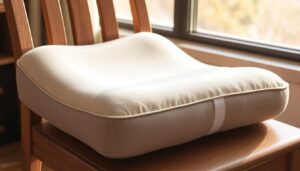New moms often face big physical challenges after having a baby. These include weakened pelvic health. The strain of pregnancy and delivery can make it hard for the body to heal, making postpartum care very important.
It’s key for new moms to have pelvic floor support to get their strength back and feel better. Ergonomic tools can also help a lot. They offer comfort and reduce the risk of long-term health issues.
Key Takeaways
- New mothers need pelvic floor support to recover from childbirth.
- Ergonomic tools can enhance postpartum comfort and health.
- Proper care can reduce the risk of long-term health issues.
- Postpartum recovery is crucial for overall well-being.
- Using the right tools can make a significant difference in new moms’ lives.
Understanding Postpartum Pelvic Floor Changes
Postpartum pelvic floor changes can deeply affect a new mom’s health. The pelvic floor muscles are key to the body’s core support. During pregnancy and childbirth, these muscles face a lot of strain.
Anatomy of the Pelvic Floor
The pelvic floor is made of muscles, ligaments, and fascia. Knowing its anatomy helps us understand postpartum changes. These muscles help control bladder and bowel functions. They also support the uterus and other organs.
Impact of Pregnancy and Childbirth
Pregnancy and childbirth can really strain the pelvic floor muscles. This can cause urinary incontinence and pelvic pain.
“The strain on the pelvic floor during pregnancy and childbirth can lead to long-term health implications if not properly addressed.”
The effects of pregnancy and childbirth on the pelvic floor vary. This depends on delivery mode and any complications.
Common Postpartum Pelvic Floor Issues
New moms may face issues like urinary incontinence, pelvic pain, and weak core. Spotting these issues early is key to managing them. Knowing about these problems helps moms take steps to lessen their effects.
Recognizing Signs of Pelvic Floor Dysfunction
It’s important for new moms to know the signs of pelvic floor dysfunction. This helps them take steps to feel better. Pelvic floor issues can show up in many ways, so it’s key to watch for both body and mind changes after having a baby.
Physical Symptoms to Monitor
Look out for urinary incontinence, pelvic organ prolapse, and trouble with bowel movements. You might feel a heavy or pressured feeling in your pelvis. This could mean there’s a problem.
Pain Patterns and Warning Signs
Pain can be different for everyone. Watch for ongoing pelvic pain, pain when you have sex, and lower back pain. Don’t think these are just part of getting better after having a baby. Talk to a doctor about them.
Emotional Impact of Pelvic Floor Issues
Pelvic floor problems can really affect your mood. You might feel anxious, depressed, or like your life isn’t as good as it used to be. It’s important to notice these feelings to get the right help.
| Symptom | Description | Action |
|---|---|---|
| Urinary Incontinence | Leakage of urine during activities | Consult a healthcare provider |
| Pelvic Pain | Persistent pain in the pelvic area | Discuss pain management options |
| Bowel Issues | Difficulty with bowel movements | Seek advice on dietary changes |
Spotting these signs early can really help. Knowing the signs of pelvic floor issues lets women get the right help. This way, they can use tools and get support to heal.
Essential Pelvic Floor Support Solutions for New Mothers
Postpartum pelvic floor support is key for new moms. It helps in many ways. It affects bladder control, core stability, and sex life.
New moms have many support options. These include exercises, devices, and ergonomic changes. Each can be adjusted to fit a mom’s needs, helping during recovery.
Short-term Recovery Benefits
Short-term, pelvic floor support helps with pain and healing. It lowers the chance of issues like incontinence and prolapse.
- Improved bladder control
- Enhanced core stability
- Reduced risk of prolapse
A healthcare expert says, “Pelvic floor support is vital postpartum. It helps women control their bodies and lowers long-term risks.”
“Pelvic floor muscle training is a highly effective treatment for urinary incontinence in postpartum women.”
Long-term Health Implications
Long-term, pelvic floor support is very important. It keeps muscles strong, lowering future risks and improving life quality.
| Health Benefit | Description |
|---|---|
| Reduced Risk of Incontinence | Strengthening pelvic floor muscles helps prevent urinary and fecal incontinence. |
| Improved Core Stability | Pelvic floor support enhances overall core strength, improving posture and reducing back pain. |
| Enhanced Sexual Function | Strong pelvic floor muscles can improve sexual satisfaction and reduce discomfort during intimacy. |
Connection to Overall Maternal Wellness
Pelvic floor support is linked to maternal wellness. It boosts physical and emotional health, making postpartum better.

Good pelvic floor support changes a new mom’s life. It offers many benefits that last long after recovery.
How to Perform a Basic Self-Assessment
Understanding pelvic floor health starts with a simple self-assessment. This lets new moms take charge of their recovery. They can use healing tips and postpartum tools to check their progress.
Step-by-Step Pelvic Floor Awareness Exercises
First, find a quiet and private spot for these exercises. Start by squeezing your pelvic floor muscles. Hold for a few seconds, then let go. Do this a few times to get a feel for it.
Listen to how your body feels. You might want to use a postpartum tool to help you find the right muscles.
Identifying Your Baseline Strength
To find your baseline strength, see how well you can squeeze and release your pelvic floor. Use a scale of 1-5. 1 means a weak squeeze, and 5 means a strong one.
Creating a Recovery Progress Tracker
Make a tracker to follow your progress. You can use a journal or a mobile app. This will help you stay on track and adjust your healing tips as needed.
| Assessment Criteria | Initial Assessment | Follow-up Assessment |
|---|---|---|
| Pelvic Floor Strength | 2 | 4 |
| Ability to Contract | Yes | Yes |
By following these steps and using postpartum tools, new moms can manage their pelvic health. They can also track their recovery progress well.
Selecting the Right Pelvic Floor Support Products
It’s important for new moms to know about pelvic floor support products. The right one can make a big difference in comfort and healing.
Postpartum Recovery Garments
These garments support and compress the belly and pelvic area. They help with swelling, circulation, and muscle support.
Key Features: Look for adjustable compression, breathable materials, and easy use.
Specialized Cushions and Seating Options
Ergonomic cushions help with pelvic floor pressure. They’re great for moms who sit a lot while feeding or caring for their baby.
Support Belts and Braces
Support belts and braces help the lower back and pelvic area. They’re hidden under clothes and adjust to fit changing needs.
Proper Fitting Guidelines
Getting the right fit is key for pelvic floor support. Follow the maker’s size and adjustment tips.
- Measure as the maker says
- Adjust for comfort and support
- Ask customer service if unsure
Duration of Use Recommendations
How long to use pelvic floor support depends on your needs and the product. Use it as the maker or doctor says.
Tips: Begin with short use and increase as needed and advised.
Ergonomic Breastfeeding Tools and Techniques
New moms can really help their pelvic health with special tools and techniques for breastfeeding. Breastfeeding is key for caring for a new baby. It’s important to find ways to be comfortable and avoid body strain.
Choosing and Using Nursing Pillows
Nursing pillows help support you while breastfeeding. They keep you comfy and ease back and pelvic floor strain. Look for a pillow that you can adjust. It should support both you and your baby’s back.
A good nursing pillow can make all the difference in breastfeeding comfort,” says a lactation consultant. “It’s not just about propping up the baby; it’s about creating a comfortable feeding position that supports the mother’s body.”

Setting Up Comfortable Feeding Stations
Having a cozy spot for feeding is key for long sessions. You’ll need a comfy chair, a footrest, and a side table for things you need. A well-lit, quiet area also helps.
- Use a comfortable, supportive chair with good lumbar support.
- Consider a footrest to reduce pressure on the pelvic floor.
- Keep a side table handy for essentials like water, snacks, and burp cloths.
Proper Positioning to Protect Your Pelvic Floor
Right positioning during breastfeeding is key for your pelvic floor. Sit straight, use pillows for back and baby support, and keep the baby at nipple level. Maintaining good posture during breastfeeding can greatly reduce pelvic floor muscle strain.
As noted by a pelvic health specialist, “Proper alignment during breastfeeding not only enhances comfort but also plays a critical role in supporting pelvic floor health.”
Baby-Carrying Ergonomics for Pelvic Health
New moms face many challenges when caring for their babies. It’s important to know about baby-carrying ergonomics for pelvic health. Carrying a baby can put a lot of strain on the body, especially the pelvic floor muscles.
Supportive Baby Carriers
Choosing the right baby carrier is key for ergonomic baby-carrying. Look for carriers that support both the baby and the mom’s back. Ergonomic baby carriers help spread the baby’s weight, easing strain on the pelvic floor.
Proper Wearing Techniques
After picking a good baby carrier, learn how to wear it right. Make sure the baby is high enough on your body. Their legs should be in an M-position, with knees above their bottom. This helps spread the baby’s weight and eases pelvic floor pressure.
Transitioning Between Positions
It’s important to switch between carrying positions to avoid strain. Try carrying your baby on your front, back, or hip. This even distribution of weight reduces pelvic floor strain and keeps you comfortable.
| Carrying Position | Benefits | Tips |
|---|---|---|
| Front Carry | Promotes bonding, easy access for feeding | Ensure baby’s legs are in M-position |
| Back Carry | Distributes weight evenly, comfortable for long periods | Adjust carrier to support baby’s back |
| Hip Carry | Reduces strain on back, comfortable for mother | Support baby’s bottom and back |
By picking the right baby carrier, wearing it correctly, and switching positions, new moms can lessen pelvic floor strain. This helps with better recovery and overall pelvic health.
How to Create an Ergonomic Home Environment
New moms can really benefit from an ergonomic home. It helps with physical and emotional health after having a baby. Making small changes around the house can make a big difference.
Optimizing Diaper Changing Areas
The diaper changing area is used a lot after a baby is born. Making it ergonomic can help avoid back pain. Use a changing table that’s the right height and keep things you need close by.
- Use a changing pad with storage for diapers and wipes.
- Position the changing table near a comfortable seating area for feeding.
Bedroom Modifications for Recovery
The bedroom should be a cozy place for rest and healing. It’s not just about a comfy bed. Think about pillows, nightstand height, and having tools for recovery like heating pads.
“A well-designed bedroom can significantly impact postpartum recovery by providing a comfortable and restful environment.”
Bathroom Adaptations for Postpartum Comfort
Making the bathroom comfy can really help after having a baby. Grab bars, a shower chair, and a comfy cushion can make a big difference. Also, keep the bathroom warm and have what you need within reach.
| Adaptation | Benefit |
|---|---|
| Grab Bars | Improved safety and balance |
| Shower Chair | Reduced fatigue while bathing |
| Ergonomic Cushion | Enhanced comfort during bathroom use |
By making these changes, new moms can make their home a healing and comfy place. This helps a lot during the postpartum time.
Step-by-Step Pelvic Floor Exercises for Recovery
Pelvic floor support is key for new moms. Exercises help a lot. They make recovery better and improve pelvic health.
Mastering Proper Kegel Technique
Kegel exercises are important for pelvic floor strength. First, find your pelvic floor muscles. Stop the flow of urine mid-stream to feel them.
Once you know the muscles, practice squeezing and releasing them.
Common Mistakes to Avoid
Don’t use the wrong muscles, like your belly or thighs. Focus on squeezing the muscles around your vagina and anus. Also, don’t hold your breath. Breathe naturally.
Progressive Training Schedule
Start with short squeezes (3-5 seconds) and relax for the same time. As you get stronger, squeeze longer and more often. A progressive training schedule helps a lot.
Breathing Coordination Exercises
Breathing exercises help with Kegels. Practice deep diaphragmatic breathing while squeezing your pelvic floor. It improves control and reduces tension.
Gentle Core Stabilization Methods
Core exercises help the pelvic floor and build strength. Try pelvic tilts and bridges gently. They’re good in the postpartum period to avoid strain.

Doing these exercises daily can really help your pelvic floor. Be consistent and patient for the best results.
Integrating Pelvic Floor Support into Daily Routines
Women after having a baby can help their healing by adding pelvic floor exercises to their daily life. This is key for lasting recovery and good pelvic health.
Exercise Opportunities During Baby Care
New moms can do pelvic floor exercises while caring for their baby. For example, Kegel exercises can be done while feeding or changing the baby. This makes the most of time spent on baby care.
Mindful Movement Throughout the Day
Adding mindful movement to daily routines helps pelvic floor health. Simple actions like deep breathing or gentle stretches while doing chores are good.
Creating Sustainable Healing Habits
New moms should make pelvic floor support a regular part of their day. This can mean setting reminders for exercises or using postpartum tools for pelvic health.
By adding these habits to daily life, new moms can greatly improve their recovery and pelvic health over time.
Proper Body Mechanics for New Moms
New moms can really help their pelvic floor by learning how to move right. This is important when they’re taking care of a new baby. Knowing how to move can help them heal faster and feel better.
Safe Lifting and Carrying Techniques
Learning to lift and carry safely is key. New moms should bend their knees, keep things close, and lift with their legs. This way, they don’t hurt their back or pelvic floor.
Optimal Posture While Caring for Baby
It’s important to keep good posture when caring for a baby. New moms should keep their spine straight and shoulders relaxed. Using an ergonomic cushion can help keep this posture, making them feel less pain.
Movement Patterns That Protect Your Pelvic Floor
It’s important to move in healthy ways to protect the pelvic floor. Avoid heavy lifting, bending, or twisting. When getting out of bed, roll onto your side and push up with your arms. This helps avoid straining your muscles.
| Movement | Proper Technique | Benefit |
|---|---|---|
| Lifting Baby | Bend knees, lift with legs | Reduces strain on pelvic floor |
| Feeding Posture | Straight spine, relaxed shoulders | Decreases discomfort and strain |
| Getting Out of Bed | Roll onto side, push up with arms | Protects abdominal and pelvic floor muscles |
By using these body mechanics every day, new moms can help their pelvic floor a lot. This makes their postpartum recovery better.
Nutrition and Hydration Plan for Pelvic Floor Health
A good diet and enough water are key for new moms to help their pelvic floor. Eating right and drinking water helps a lot with healing and feeling good.
Foods That Support Tissue Healing
Eating foods full of good stuff helps fix tissues and make pelvic muscles strong. Some great foods are:
- Lean Proteins: Helps fix tissues and make muscles strong.
- Vitamin C-rich Foods: Helps make collagen and heal faster.
- Omega-3 Fatty Acids: Lowers inflammation and keeps you healthy.
- Zinc-rich Foods: Important for healing wounds and keeping the immune system strong.

Hydration Strategies for Recovery
Drinking enough water is very important for healing after having a baby. New moms should drink lots of water all day. Hydration tips:
- Drink at least 8-10 glasses of water every day.
- Check your urine color to make sure it’s pale yellow.
- Don’t drink too much caffeine or sugary drinks.
Meal Planning for Busy New Mothers
Planning meals can be hard for new moms, but there are easy ways to eat well. Tips for meal planning:
- Make meals ahead of time.
- Have healthy snacks ready.
- Choose simple, nutritious meals.
When and How to Seek Professional Pelvic Floor Support
Knowing when to get help is key for pelvic floor health. New moms face many challenges after giving birth. It’s important to know when to ask for help.
Indications for Physical Therapy Intervention
Physical therapy is important for postpartum recovery, especially for pelvic floor health. You might need it if you have pelvic pain, trouble controlling your urine, or pain during sex. Experts say early help can greatly improve things.
Early intervention can significantly improve outcomes for women experiencing pelvic floor dysfunction.” –
If you’re feeling these symptoms, see a healthcare provider. They can help figure out what to do next.
What to Expect at Your First Appointment
Your first physical therapy visit will check your pelvic floor. You might have an internal exam to see how strong your muscles are. The therapist will also talk about your symptoms and health history.
Preparation is key. Write down your symptoms and questions before you go. This way, you won’t forget anything important.
Insurance Coverage and Access to Care
Many insurances cover pelvic floor physical therapy. But, what’s covered can change. Always check with your insurance to know what you have.
Ask your healthcare provider for a referral to a pelvic floor specialist. This can make it easier to get the care you need.
By getting professional help when you need it, new moms can heal and get stronger after having a baby.
Advanced Ergonomic Tools for Postpartum Recovery
Advanced ergonomic tools are key for new moms after birth. They offer comfort, support, and healing benefits. This helps new moms feel better and heal faster.
Specialized Exercise Equipment
Special tools for exercise help a lot after birth. Pelvic floor exercisers and abdominal support devices are great. They help strengthen muscles and improve health.
These tools are safe and easy to use at home. They help new moms get stronger and feel more confident.
Biofeedback Devices and Apps
Biofeedback tools and apps are a new way to check pelvic floor health. They show muscle activity in real time. This helps users know if they’re doing it right and see how they’re improving.
- Pelvic floor muscle training apps
- Biofeedback devices with sensors
- Personalized coaching and feedback systems
Therapeutic Modalities for Home Use
Home use of heat and cold therapy, electrical stimulation, and ultrasound therapy helps too. They can lessen pain, help healing, and relax muscles. Always follow the instructions and talk to a doctor first.
Using these tools, new moms can take care of themselves better. This helps them have a stronger, healthier future.
Conclusion: Your Roadmap to Postpartum Pelvic Health
New moms can keep their pelvic floor healthy by adding support to their daily life. Using tools like nursing pillows and ergonomic cushions helps a lot. These tools lessen the strain on the pelvic floor.
Following the tips in this article helps women recover well after having a baby. It’s important to be careful with how you move your body. Also, doing pelvic floor exercises is key.
Tools like baby carriers and special exercise gear are very helpful too. They support the pelvic floor. By using these tools and focusing on pelvic health, new moms can stay healthy and active.
FAQ
What are the most common pelvic floor issues new mothers face postpartum?
New moms often face pelvic floor problems. These include urinary leaks, pelvic organ prolapses, and painful sex. This is because pregnancy and childbirth put a lot of strain on the pelvic floor muscles.
How can I identify if I have pelvic floor dysfunction?
Look for signs like leaks, pain, or trouble with bowel movements. Feeling anxious or depressed can also be a sign.
What are the benefits of using pelvic floor support products?
Pelvic floor support products offer quick relief and help in healing. They also help strengthen the core and pelvic floor after giving birth.
How do I choose the right ergonomic breastfeeding tools?
Choose nursing pillows that support you and your baby well. Set up comfy feeding spots to avoid straining your pelvic floor.
What are some tips for creating an ergonomic home environment for postpartum recovery?
Make diaper changing areas easy to use. Make your bedroom comfy and your bathroom safe for postpartum use.
How can I integrate pelvic floor exercises into my daily routine?
Do Kegel exercises and breathing exercises daily. Do them while caring for your baby. Make these habits part of your routine.
What are some proper body mechanics for new mothers to protect their pelvic floor?
Use safe lifting and keep good posture while caring for your baby. Move in ways that don’t strain your pelvic floor.
How does nutrition and hydration impact pelvic floor health?
Good food and water are key for pelvic floor health. They help with healing, keep muscles strong, and support overall health
When should I seek professional help for pelvic floor issues?
Get help if you have ongoing or severe pelvic floor problems. Look for physical therapy if you have pain, leaks, or bowel trouble. Know what to expect at your first visit and check your insurance.
What advanced ergonomic tools are available for postpartum recovery?
There are special tools for recovery, like exercise gear and biofeedback devices. They help improve pelvic floor strength and overall health.







